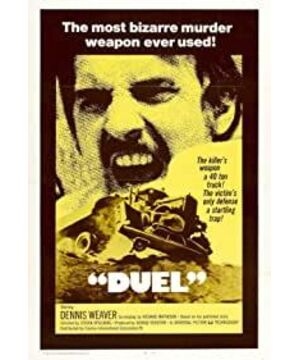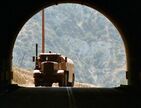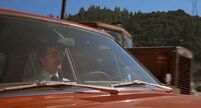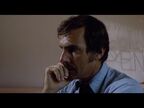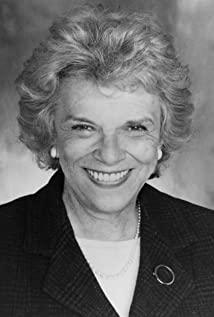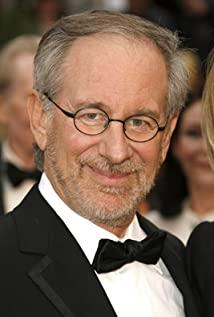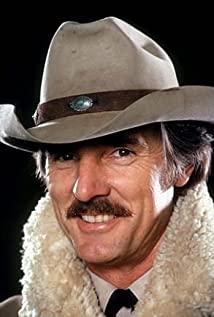Note: This film review exposes the plot of the film. The purpose of this article is to let readers understand how Spielberg uses narrative techniques and lens processing for this film. Of course, it is possible that another kind of insight will be gained when going to the movies after understanding this. On this point, the benevolent see the benevolent and the wise see the wisdom.
Less is more , is Mies Van der Rohe's most impressive sentence. His words are concise and philosophical. He said so and did so. One of his greatest works, the German Pavilion at the Barcelona World Expo, is the best expression of this sentence.
Less lies in its form, and more lies in the viewer's complicated inner thoughts triggered by the lack.
Similarly, Spielberg's Virgo "Duel" is also a work of art that less is more. Rarely is that there is only one protagonist, the male protagonist. Most of it lies in Spielberg's brilliant treatment of less from the perspective of film art. From the perspective of the shooting props and scenes, "Duel" is also very simple and clear, allowing us to examine his narrative and lens processing more without distraction.
Before entering the duel, first explain the author's superficial understanding of the art of film, which is also the theoretical basis for the author to explain the narrative and lens of the duel.
Compared with novels, movie is a purely material art (in a narrow definition, movies cannot invade the hearts of characters at will like novels, so they can only express their emotions through materialization). Don't underestimate this substance. What we call emotions, spirits, or thoughts hidden behind the substance that can be understood and empathized by the audience is the true essence of this art. The role played by the director is to build a perfect bridge between material and corresponding thoughts, feelings and spirits. Spielberg is one of the outstanding bridge engineers.
The reason why film is called pure material art, we can understand the essence of film a little bit. To put it simply, a complete movie is composed of perceptible material means such as shots, clips, soundtracks, and CG post-processing (if necessary) broken down from the script. Everything about the actor is included in it, so the performance and spirit, emotions and thoughts he paid after he understood the script and the role in the filming process are omitted here. Besides, their outstanding contributions will eventually be rewarded on the screen, if the work is really worth it.
As viewers, everything we see and hear on the screen is a certain form of permutation and combination of matter. For example, someone is doing something in a certain place at a certain time (long shot), some kind of staring eyes (close-up), some kind of obscure body language (medium shot or panoramic shot), some kind of frightening words (audio track), Some kind of gentle music (sound track), etc. The reason why the proper arrangement and combination of these initial discrete substances will resonate after we look at them and give them sympathy is because the internal impressions triggered by these substances are in our brains. The emotional zone (the result of years of accumulated life experience) produces a subtle coordination effect. The production of this coordination between the broadcast material and the audience's spirit, and how it may be produced and how it can be derived and expanded is the director's heavy responsibility.
Back to the duel.
From a narrative point of view, the storyline of the film is straightforward. That is to describe what happened in the period from the beginning of a long-distance driving to the end of the destruction of the car. This straightforward narrative method should be said to be as old as Aristotle's story principle. But it was used by Spielberg handily and fascinatingly. How did he do it? And how is this seemingly simple story turned into a metaphor?
The video screen starts from the black fade in (the screen sound prompts us to start the car), and then a very long follow-up shot. Unlike the tangible follow-up, Spielberg's follow-up object is the road itself. And the lens is placed in a very low position, we can understand from the following screenshot of the movie. A very low lens means a very low point of view, which tends to produce a more tension effect in the picture.
In racing games, such as the ridge in the host game, EA's Need for Speed in the computer game, etc., there are three common interface modes. One is the first person (the point of view is in the car) mode, the other is the third person (god's perspective) mode, and the last is the unmanned mode, which means that only the road mode is displayed. Among the three, the road mode is the one that most pursues the stimulation of speed and does not care about the feeling of the operator's simulation.
Spielberg's intention to set the camera in the road mode for a long period of time during the opening of the duel was also very obvious, and this also paved the way for the subsequent plot.
It wasn't until four minutes and thirty-two seconds into the movie, after a long shot of a road, that the protagonist appeared for the first time. And for the first time, it appeared as a close-up in the rearview mirror, followed by a close-up of the car radio, which is an explanation of the broadcast sound that has always appeared, and finally the protagonist's mid-to-close shot. This aroused the author's curiosity. Why?
In Proust's novel "Reminiscing about the past years", some small objects have become the poetic features of his unintentional memory. For example, the Madeleine cookies soaked in tea; the spire of Madanville clock tower seen from the two-wheeled chaise; the musty smell permeating the public toilets on the Champs Elysées, etc. These seemingly insignificant unintentional memories (remembering the body but always responding) constitute the most distinctive feature of Proust's entire memory building. Unconscious conscious recall and memory, and unconscious forgetting of conscious memory can always make people sad, isn’t it?
The reason why Spielberg gave the male lead to the rearview mirror for the first time was not unconscious, but deliberate. It is through the rear-view mirror (the main close-up appears repeatedly in the movie) that it gives him a kind of acceleration in the narrative, a kind of inexplicable panic that is gradually rendered, which is both the protagonist and yours. , Through the empathy of the rearview mirror: the logical repetition of the same lens is also a poetic establishment of the film.
Taking the roadside cafe as the dividing line, the road pattern appeared repeatedly before, and then disappeared. Because the situation has changed from a competition of speed and emotion to a question of life and death.
The narrative mode of the duel is very simple, but its application is quite interesting. It can be discussed by combining the shots of the two scenes. The narrative is divided into three stages. The first stage is the racing stage, the second stage of racing evolves into a question of life and death, and the third stage is a duel of life and death. The watershed between these three stages is also very clear, namely, gas stations and roadside cafes. Before entering the gas station, it was racing and emotional, and after the roadside cafe was a duel.
Throughout the movie, as seen below, Spielberg's road chase shots can be said to be completed around the rearview mirror. Close-up of the rearview mirror, panoramic view of a large truck, close-up of a large truck, and a close-up of the rearview mirror. A roadside reference for quick appearance at the over-the-shoulder lens (the rearview mirror can be used as an object here), plus a close-up of the male protagonist and a close-up of the speedometer Waiting to complete a kind of racing chase mood gradually heats up and finally turns into horror rendering.
If the duel is only a violent speed chase, without reasonable and appropriate logic behind it, then everything will be in the mirror, extremely boring. Therefore, the design of a set of lenses at the gas station is very interesting. We can analyze it carefully.
In the film, the male protagonist makes a phone call to his wife at the gas station. The design of the scene lens implied the logical support for the next few steps of the plot, and Spielberg did it seamlessly when he leaked it out. Let's see how he did it. I won’t say much about the details of the phone, and readers can read the film by themselves. The purpose of the phone call is to let the audience know the reason why the male protagonist cannot drive or even park afterwards through the unhappy conversation between the two couples.
To some extent, the cinematic lens is the point of view. With a point of view, smart viewers will think that someone is there watching the male lead make a phone call, and it is easy to play and not easy to be empathized. This is why Spielberg had to add a woman picking clothes in the washing machine in the close-up scene in the gas station phone scene, and put the man on the phone in the panorama from time to time. At this point, we obtained the phone information when we knew that the prospect was constantly moving, and her appearance was to break our previous notion of nonsense. Isn't it perfect? If we were the director, imagine that we remove the woman in the foreground, then what kind of expression would this scene be like? This can be used as homework for readers.
Spielberg can arouse people's emotions. This is fully revealed in the cafe series of shots. First, in the cafe toilet, the voice-over was used to reveal the self-comfort of the male protagonist, thinking that it was just a short emotional out-of-control in his life, and everything was over. The big truck had already driven far ahead. Then, a close-up and follow-up shot was taken into the audience. With the male protagonist, he walked from the toilet to the window and saw the situation and real mood of the big truck that should have been far away suddenly stopped on the road in front of the cafe.
Like any normal person, it would be a strange thing if you weren't afraid to fly with your thoughts at this time. Naturally, the male protagonist began to look for the driver in the cafe and let himself go. Here are a few shots worth talking about. One is that the following foreground is out of focus, and the background focus is to reflect the male protagonist’s anxiety and worry and many suspicious candidates. The second is a close-up close-up of a leather boot that echoes the boot seen by the man at the gas station and a vertical pan to examine everyone in the cafe. This set of shots is great.
What I like most here is the shot of the hostess's hand in the middle shot of the hostess and the scary sound of throwing the tableware onto the table, which indicates that the hostess is not right with the atmosphere of the whole cafe. Afterwards, the male lead clashed with one of the people in the restaurant based on his imagination, and later proved that the man was not the driver the male lead was looking for. The host was therefore asked to leave by the owner of the restaurant. In fact, from the beginning to the end, the driver of the big truck was not in the restaurant at all, so why did Spielberg bother to describe the things in the restaurant?
Because it wants to make a reasonable explanation for the foreshadowing of the content of the male host's phone call at the gas station. On the phone, the male lead’s wife was almost raped by the male lead’s colleague at a company party. His wife meant that the male lead should teach that person for him (at least a curse is fine), but the male lead But hesitating is reluctant. Such a man does not have this paragraph in the restaurant, how is it logical to have the courage to fight in the final stage? After carefully analyzing the movie, I realized that the gas station is a very interesting point. In the final duel stage of the film, the hero's heat pipe broke. This once again responded to the situation where the worker at the gas station helped him check the car and asked him if he wanted to change the heat pipe, but he laughed it off. Of course, this is the normal reaction of all of us most of the time. They just want to make more money. In fact, there is another layer of information reflected here. According to the way the male protagonist usually drives, it is only sixty to seventy steps away, so that the radiator will not be broken. This seemingly unintentional message is actually the triggering point of the entire duel story.
Going back to the beginning of the film, we need to understand why two mutual overtakings led to the subsequent duel and even the sacrifice of life? It turns out that the engine of the big truck is old and will continuously emit thick smoke during operation. Faced with such a situation, the male protagonist naturally has to overtake to his front. Then, according to the habit of the male protagonist, his accustomed speed happened to make his car fall not far in front of the big truck, which is a provocation for the big truck driver. Because according to the usual purpose of overtaking, the person who is being overtaken will quickly leave. Of course the big truck driver has to overtake the car back. In this way, they started a meaningless and emotional race, which in turn responded to Spielberg's road mode shots used at the beginning.
The last interesting question about this film is who is the driver of the big truck? As shown in the picture above, no one is, and no one is. Spielberg did not allow the driver of the big truck to show up, except for the gas station and the hand that occasionally appeared on the road, no relevant information, but the nightmare of the big truck is everywhere in the movie. When this nightmare appears more often, gradually, the audience will unconsciously realize that the big truck is a metaphor, that is, the road rage that we all encounter may happen at any time. As long as there is no good attitude, any trip on the road will become a duel of life and death under any unintentional factors. This is probably the biggest metaphor of Spielberg's film.
View more about Duel reviews


